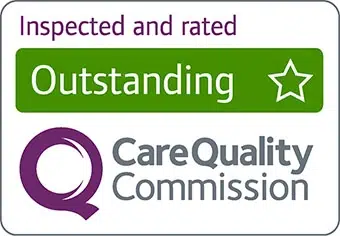What Is a Seizure?
Seizures are characterised by changes in an individual’s behaviour, movement, or consciousness. Abrupt and uncoordinated electrical firing in the brain is the main cause of seizures.
Additionally, they can happen day and night because of various reasons, including:
- Genetic factors
- Head injuries
- Medical conditions
Seizures can vary in severity and differ from one person to another. Some individuals might experience mild seizures that go unnoticed, while others might have challenges with severe seizures that require medical assistance.
Therefore, it’s essential to better understand the different types of seizures and their characteristics.
Focal Seizures (Partial Seizures)
A focal onset seizure, also known as a partial seizure, starts from one area in the brain and then progresses throughout other areas. Focal onset seizures can manifest in mild or severe symptoms depending on how much of the brain is affected.
When the abnormal electrical activity progresses into a large area of the brain, individuals might experience:
- Sense of confusion
- Muscle stiffening, minor shaking, or chewing motions
- Involuntary movements
- Changes in vision
When focal seizures result in altered awareness, they’re referred to as focal unaware seizures or complex partial seizures. Additionally, the electrical activity of the seizure can remain in one area of the brain, resulting in a focal aware seizure.
What to Do in Case of a Focal Seizure?
If someone around you is having a focal seizure, it’s important to take a few appropriate steps to ensure their well-being.
Stay calm and try to reassure the individual that’s experiencing the seizure
If the individual shows symptoms of involuntary movements, remove any nearby objects that could harm them
Calmly guide the person to the ground and put a cushion or anything soft behind their head
If it is someone’s first seizure or the seizure lasts for more than five minutes, call an ambulance
It’s crucial not to restrain the individual in any way while they’re showing symptoms.
Focal seizures can be the cause of immense stress or anxiety. Therefore it’s crucial to remain calm and supportive even after the symptoms of focal seizures are gone.
Generalized-Onset Seizures
Generalised seizures happen when there is seizure activity in both hemispheres of the brain. The most common cause of these seizures is when there’s an imbalance of inhibitory circuits and excitatory circuits in the electrical activity within the brain.
There are ongoing studies on the genetic factors as the cause of generalised seizures. However, only a small number of individuals who experience these types of seizures have family members with the same condition.
Types of Generalized-Onset Seizures
Generalised seizures are complex and have different symptoms and treatment options. Hence, it’s crucial to understand the different types of generalised-onset seizures better in order to know how to deal with them once they occur.
Absence Seizures (Petit Mal Seizures)
An absence seizure usually occurs in young individuals between the ages of 4 and 14. However, adults might also experience absence seizures, although it’s less likely.
Absence seizures might include symptoms such as:
- Unconsciousness (usually involving a blank stare)
- Loss of muscle control
- Rapid breathing
- Rhythmic blinking
These seizures usually occur and end abruptly and tend to last around 10-15 seconds. Once the seizure has stopped, the individual tends not to experience confusion or disorientation.
Tonic-Clonic Seizures
With generalised tonic-clonic seizures, electric discharges affect the entire brain, and the individual will lose consciousness.
During the tonic phase, the muscles stiffen entirely, and the individual won’t be able to stand. Additionally, during this phase, the individual might experience increased pressure on the bladder or may bite their tongue, which may cause bleeding.
During the clonic phase, the individual will portray signs of rhythmical twitches and jerk movements. Unswallowed saliva might also come out of the mouth.
Tonic-clonic seizures might last from one to three minutes.
How to Help Someone During a Tonic-Clonic Seizure
Once you notice someone around you experiencing a tonic-clonic seizure, it’s important to assist them gently to the ground in the first stage when their muscle stiffen. Then, make sure to put something soft under their head and neck. If you’re in an outdoor environment, a folded sweater, scarf, shirt, or any type of material can suffice as long as it’s soft.
Make sure to check the time once the seizure begins. If the seizure doesn’t stop after 5 minutes or the individual is experiencing another seizure right after the first one, it’s crucial to call an emergency service.
Additionally, it’s crucial to remain with the individual after the seizure subsides as they may be disoriented, confused, and extremely fatigued.
Tonic and Atonic Seizures
Tonic seizures tend to develop during childhood; however, they can occur at any age. These seizures are characterised by facial and truncal muscle spasms, flexion or extension of the upper and lower extremities, and loss of consciousness.
Atonic seizures are characterised by a loss of muscle tone, which can cause a person to collapse. Additionally, while the seizures are happening, individuals might experience confusion, loss of consciousness or jerking movements in the body.
Non Epileptic Seizures
Non-epileptic seizure is a term that describes seizures that do not occur as a result of abnormal electrical activity in the brain. These seizures can be caused by various factors, including:
- Trauma or PTSD
- Emotional stress
- Psychological stress
- Physical injury

When it comes to diagnosis, non-epileptic seizures are hard to underline because they often share similar symptoms with epilepsy.
One of the most common non-epileptic seizures is dissociative seizures.
Dissociative Seizures
Dissociative seizures are mainly triggered by psychological or emotional stress, anxiety, or trauma.
Although dissociative seizures have similar symptoms to epileptic ones, there are a few essential differences.
Because these seizures are not caused by abnormal electrical activity in the brain, there might be no abnormal movements. These seizures are often misdiagnosed as epilepsy because the symptoms can be similar, and individuals with dissociative seizures may also have a history of actual epileptic seizures.
Dissociative Seizures Diagnosis
Once individuals start experiencing seizures, they will usually be referred to a neurologist to try and determine the cause of the seizures. If a medical professional cannot find signs of abnormal electrical activity, individuals will be referred to a psychologist.
There are no symptoms that will definitely identify dissociative seizures from epileptic seizures. Therefore, the diagnosis process might take a longer period of time. However, being patient and finding the right support during this time is crucial because the proper diagnosis will ensure proper treatment.
Dissociative Seizures Treatment and First Aid
The treatment of dissociative seizures usually entails working out the underlying psychological causes and their triggers.
Cognitive-behavioural therapy, psychodynamic therapy, or group therapy are all treatment options for dissociative seizures. However, depending on the severity and main causes – a medical professional will determine which option is best suited for the individual.
Myoclonic Seizures
Myoclonic seizures include symptoms of brief and involuntary muscle jerks that can affect any muscle group in the body.
There are a variety of causes for this type of seizure, including:
- Genetic factors
- Developmental differences
- Head injury
- Brain tumours
- Side effects of medications
- Alcohol and drug withdrawal
When an individual is experiencing this type of seizure, they tend to portray sudden muscle contractions, which can be brief or may occur in a series.
Difference Between a Myoclonus (Muscle Spasm) and a Myoclonic Seizure
The main difference between myoclonus and myoclonic seizures is that myoclonus (muscle spasm) is a single muscle twitch or spasm, while myoclonic seizures usually involve multiple muscle twitches or jerks that can occur in a repetitive pattern.
While myoclonus and myoclonic seizures can have similar symptoms, it is important to distinguish between the two in order to develop an appropriate treatment plan.

Best Practices in Assistance with Seizures
Assisting individuals experiencing any type of seizure can depend on the severity and the symptoms. However, there are a few practices that can ensure the well-being of the individuals experiencing seizures.
Remaining calm – it’s crucial to stay as calm as possible if someone around you is having a seizure. Panicking might only additionally escalate the situation and cause harm to the individual
Make sure they’re in a safe environment – it’s essential to remove sharp objects or any other object that can cause harm to the individual. Putting a soft pillow or material under someone’s head is the best practice
Loosen tight clothes – if the individual is wearing something tight around their neck, try to carefully remove or loosen the material. This will enable the individual to breathe with better ease
Time the seizure – making sure you check the time once the seizure starts happening can ensure the well-being of the individual. If the seizure lasts more than five minutes, it’s crucial to seek emergency service
Comfort the person – after the seizure has ended, stay with the person and offer comfort and reassurance. Allow the person to rest for a while before attempting to move them
Overall, the key to assisting someone with a seizure is to remain calm, keep the person safe, and seek medical attention if necessary. With proper care and support, most people with seizures are able to manage their condition and live healthy, fulfilling lives.
Promoting Safety and Independence with Leaf Complex Care
For our clinicians at Leaf Complex Care, creating a better world for individuals with complex care needs is a calling.
We provide tailored support for children and adults needing care and support in their homes. Additionally, we provide waking night care and meet your requirements and needs any time of the day. Our support workers lead people on their journey to independence with dedication, patience, and kindness.
We understand the challenges of experiencing seizures, and our goal is to benefit individuals with an empathetic and compassionate approach.
If you are searching for a care provider for yourself or a loved one, contact Leaf Complex Care. We offer support services in Bristol, Slough, Somerset, and the Midlands.


















